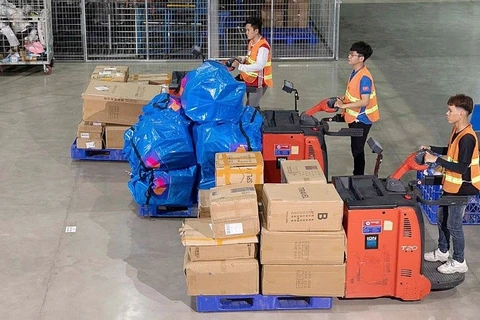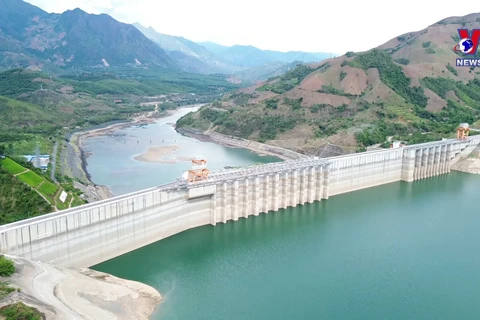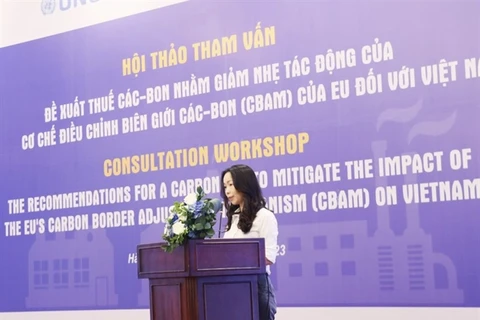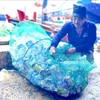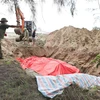 Enterprises promote energy saving solutions and streamline production processes. (Photo: VietnamPlus)
Enterprises promote energy saving solutions and streamline production processes. (Photo: VietnamPlus) Hanoi (VNA) – As the European Union (EU)’s Carbon Border Adjustment Mechanism (CBAM) will enter into application in its transitional phase from October 1, 2023, Vietnamese businesses are forced to join in the “green race” in the context that Vietnam is the union's largest trading partner in the Association of Southeast Asian Nations (ASEAN).
The CBAM, which was legislated by the European Parliament (EP) on April 18, 2023, will begin a three-year transition period from October 1 this year. After this time, the mechanism will be fully implemented from January 1, 2026.
Currently, the EU has published a draft regulation implementing the CBAM, which includes details of the reporting obligations and necessary information about CBAM items from importers.
During the transition period, importers will be obliged to report appropriate emissions from imported goods covered by the regulation.
The CBAM will introduce a carbon price on imports of specific products with a high risk of emissions to prevent the relocation of production to countries that have lower or lax carbon emission standards compared to the EU.
Therefore, when the traditional advantages of available workers and cheap raw materials are no longer a prerequisite, Vietnamese businesses should proactively seek information and improve production processes. This will allow them to quickly meet carbon tax barrier standards in major markets, in order to gain new competitive advantages, which play a decisive role in the new race in the global supply chain.
It can be affirmed that the CBAM is not something new, as it is part of the European Green Deal (EGD) launched in 2019 to address climate and environmental challenges.
For Vietnam, one decade ago, Resolution 24-NQ/TW dated June 3, 2013, of the Party Central Committee was issued to proactively respond to climate change and strengthen natural resource management and environmental protection. Since then, climate change response, natural resource management and environmental protection have received more attention. Up to six subsequent resolutions have been issued, thus helping complete institutions and policies with new thinking, in accordance with international practices and current trends.
However, changes in the world and domestic contexts require new adaptations in both the promulgation of institutions and policies, as well as the awareness and actions of businesses.
In the context that the global playground has changed, for Vietnamese exporters, the existing risk is difficulty in exporting to the EU market. This is not only a challenge for businesses that have never exported to the EU, but also for those that have experience in this market. Standards that are already familiar as well as certifications now change, with even more requirements.
In fact, the understanding by Vietnamese businesses of EU green standards is quite limited. According to a survey in 2022 by the private economic development research board under the Prime Minister's Advisory Council for Administrative Procedure Reform, the proportion of surveyed businesses that clearly understand the CBAM’s content reached only about 11%. Up to 53% did not know about it, and around 36% had heard about it but did not understand clearly.
 La Gan wind power project expected to provide electricity to more than 7 million households. (Photo: VietnamPlus)
La Gan wind power project expected to provide electricity to more than 7 million households. (Photo: VietnamPlus) While FDI enterprises, especially those headquartered in Europe and the US, are very proactive in meeting these high standards, Vietnamese businesses, particularly small- and medium-sized enterprises, are still afraid or do not have enough resources to transition to green production that requires large financial resources and the application of high technologies.
According to information from the website europa.eu, the CBAM will initially be applied for six types of imported goods with high risk of pollution. These include iron and steel, cement, fertiliser, aluminum, electricity, and hydrogen. This group of goods currently accounts for 94% of the EU’s industrial emissions. Therefore, goods imported into the EU will have to report the amount of emissions when being produced. If they exceed the standard, they will have to buy emission certificates at the current carbon price in the EU.
It means that the CBAM will make it more difficult for manufacturers in developing countries to compete in the European market as the price of their goods, after being taxed on emissions, is not much cheaper than that of those produced by European enterprises.
Therefore, as for Vietnam, experts recommended Vietnamese businesses to take steps to reduce carbon emissions right in the production process.
One of the important commitments that Vietnam has affirmed before the international community is the one its Prime Minister made at the 26th UN Climate Change Conference in November 2021 on cutting greenhouse gas emissions. With this pledge, Vietnam was well recognised by the international community for realising international commitments to combat climate change.
To achieve that goal, the Vietnamese Government has issued a series of documents to create a legal corridor so that domestic small and medium-sized enterprises with different industries and fields are also compatible with promulgated policies.
 Consumers are increasingly demanding on green and sustainable production standards. (Photo: VietnamPlus)
Consumers are increasingly demanding on green and sustainable production standards. (Photo: VietnamPlus) In line with the goal of reaching net zero emissions by 2050, the Ministry of Natural Resources and Environment is actively developing a scheme for the development of a domestic carbon market. This scheme places emphasis on the mandatory trading of GHG emission quotas for industries and businesses within the domestic carbon market, while also considering international market integration.
The roadmap for this project outlines the commencement of piloting by 2025, with the official operation of a carbon credit exchange by 2028.
The carbon market is considered the solution and key to achieving the net zero goal for Vietnam in the coming time. The market operates on the principle that "polluters" must pay a fee to compensate for emissions into the environment through the trading and exchange of carbon credits. The State receives budget revenue when it applies the collection of fees from the exchange of carbon quotas and credits or carbon taxes in the future.
According to the Ministry of Natural Resources and Environment, the impacts of climate change caused Vietnam to lose about 10 billion USD in 2020, equivalent to 3.2% of GDP. Notably, Vietnam has quadrupled its per capita greenhouse gas emissions this century and is maintaining the fastest growth rate in the world. This situation has pushed Vietnam to act strongly, responsibly and without delay to protect the environment.
Participating in the carbon market is both a responsibility and an opportunity for organisations and businesses.
The good news is that to date, Vietnam has had many outstanding financial policies on taxes, fees and economic tools to help businesses develop green production, including the Law on Natural Resources Tax stipulating tax rates to ensure the principle that non-renewable resources will be subject to high tax rates.
Thanks to these policies, the National Progress Report by the Sustainable Banking and Finance Network (SBFN) stated that Vietnam ranked in the second group of countries with significant progress in sustainable development in 2020-2021./.

